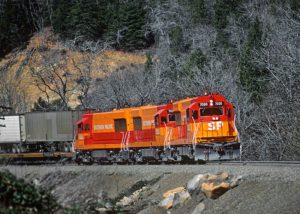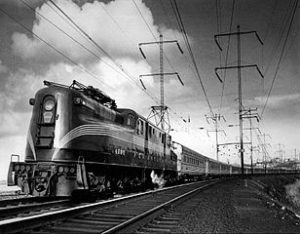Sometimes people mistake a locomotive for a train but there is no mistaking a train for a locomotive. And just like a locomotive isn’t a train and a train isn’t a locomotive, there should be no confusing steam with diesel-electric with diesel-hydraulic with straight electric with hydrogen (fuel-cell-electric) locomotive power. The type of energy supply really is the main factor in determining the locomotive’s physical appearance.

Electric, diesel-hydraulic, as well as diesel-electric locomotives can, and oftentimes do resemble each other, the differences in their physical appearances being nuanced. Sometimes it’s tough to distinguish one from the other, especially when the differences between each are internal.

There should be no argument when it comes to selecting the unequivocal leader where efficiency or performance is concerned: the straight electric. For many a railway company and on many a pike (railway) electricity is the energy supply of choice.
Even among the electric field there are multiple entries: Battery-electric, diesel-electric, fuel-cell-electric (hydrogen) and straight-electric, or simply electric, also sometimes going by the electric-electric moniker.
It is the battery-electric railway conveyance that will be further explored here.
Besides the electricity energy supply being extremely plentiful and relatively cheap because it is comparatively easy to produce, battery-electric operation has its own advantages as in said conveyances are clean-running which make them well-suited to operate in locations where air pollution is known to be a problem.

Moreover, the battery-electric locomotive or train fills the bill quite nicely where a railroad cannot or does not want to fully electrify operations due to the expense and/or the undertaking of physically installing the overhead or third-rail electric infrastructure. In addition, battery-electric power could save railroads money in the long run due to reduced equipment maintenance and fuel costs. It is quite conceivable that the money saved could instead be used to purchase additional locomotives and/or trains, or perhaps even fully electrify a line or entire operation.
On the cutting edge
As it happens, one of the newest entrants, or maybe the newest entrant, into the field is Siemens Mobility’s (of Germany) Mireo Plus B battery-powered train offering.
As explained in a Mar. 17, 2020 company press release, “Landesanstalt Schienenfahrzeuge Baden-Württemberg (SFBW) has ordered 20 Mireo Plus B trains from Siemens Mobility. The two-car electric trainsets with 120 seats can operate on all rail routes with or without overhead power lines thanks to their battery hybrid drive, and are scheduled to operate in Network 8 of the Ortenau regional system.”

As for range, Siemens expressed that on battery-power only in actual railway use which the company terms “real conditions”, the Mireo Plus B trains can travel a distance of about 80 kilometers. According to Siemens Mobility, battery recharging can be accomplished one of two ways: via overhead catenary wires in electrified territory or through the energy generated from slowing through a process called regenerative braking. The containers for the bank of batteries, of which there are two per train, are underfloor-mounted. Battery electricity comes courtesy of a “long service life,” lithium-ion supply.
“‘We’re breaking new ground in converting to climate-friendly propulsion systems in local transport by introducing this new technology and want to commit the company to this technology through contractual arrangements,’” Baden-Württemberg Minister for Transport Winfried Hermann in the release said.
Adding to this, “Andreas Ufer, Managing Director of KfW IPEX Bank, said: ‘The financing not only contributes to an immediate reduction in CO2 emissions, but also promotes innovative and climate-friendly technologies in rail transport.’”
Final delivery for the 20-unit order, meanwhile, is expected to be completed by December 2023.
Images: Roger Puta (2nd); Association of American Railroads (3rd); Siemens Mobility (bottom)
Well reported, Thankyou.
One difference we have suggested before is to turn these rail vehicles into rail aligned track less vehicles whereby the routing can be accessed by embedding rail free access points located either in a road surface or through radio-contact systems.
The system works very much as projected except that the routes are not permanently fixed and the length of “trains of carriages” can be increased or decreased to accommodate carriages joining and leaving the primary routes.
Herein lays the option from which conventional rail-directed routes miss.
With a contactless rail system such as embedded electrical points and perhaps at “train” stops to allow people access (and be local battery charging points) or electronic tell tales or transducer or equivalent placed in conventional roadways (as part of the surface dressings say) as well as at recognised positions (say for example at road junctions, bridges, underpasses and tunnels as examples) or on local specialist receptor/recorder/transducer placements (on defined structures maybe poles or fixed to buildings at specific points recognised on the routes such as bridges major buildings etc) so that the “train” can follow its pre-determined route. Such a system could then be adjusted to accommodate changes in demographics and needs thereto, or arranged so that new passenger “carriages” could join the system and form longer “trains” so reducing the demand of smaller units taking up space. In a similar vein new routes could be added and extended to reach the oft omitted sections of the populous. By using such a system which could be powered by overhead electrical lines spaced to support the ongoing “trains” these can then be made more flexible in use and could even be corralled to specific routes – as for example where dedicated journeys across bridges or tunnels that are often built to connect islands and then they could be designed to travel steeper routes more akin to traditional road carriageways.
With such an adjustment – Siemens who seem to be at the forefront here in Europe – and others – such as Daimler-Benz, and Volkswagen, and Hyundai and Mitsubishi and Volvo – could then be working through this development so that the enormity of costs can be reduced by prevention of rail lines and their limited travel routes and gradients as well as their restrictive and impediments to adjust to the needs of people rather than rail companies.
With latest control systems the need for a degree of remote control is still needed but that is not insurmountable.
The ultimate goal is passenger flexibility and being able to adjust to the changes of demographics in Society.
Siemens I applaud you here for this work but let’s go further.
We are here to help.
Peter Hurrell,